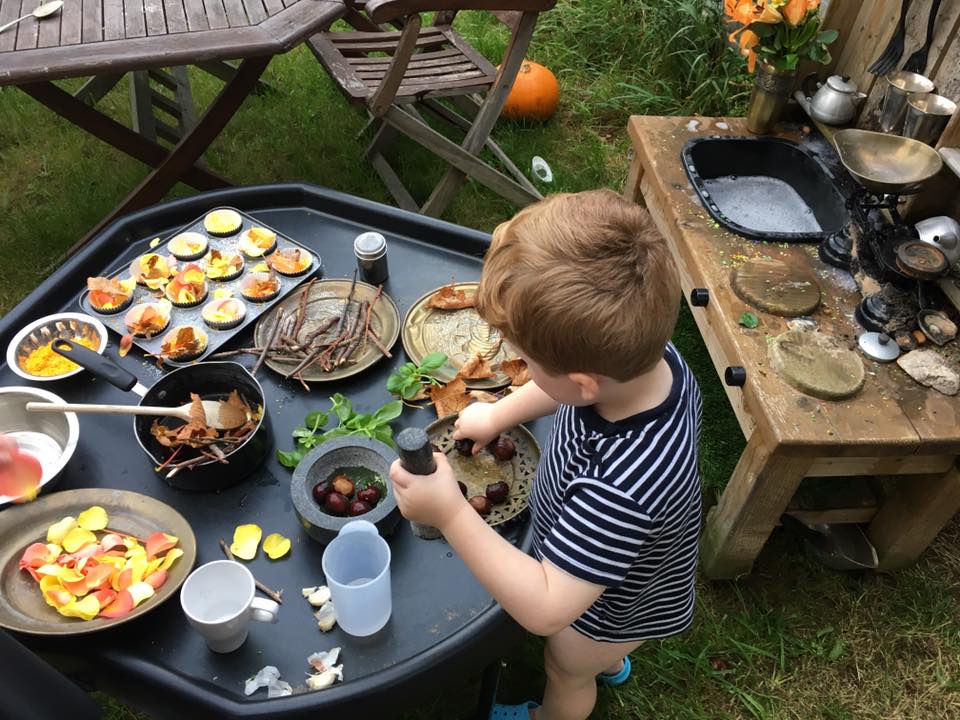As Early Years Practitioners, we know children need to be outside. But do we really know why? I hear many people saying that they are not getting the right support to provide an effective outdoor environment so we need to ask the question ‘Are we explaining why outdoor learning is a necessity effectively?’
Why do children in Early Years need free access to the outside?
- Accurate assessment – Children act differently outside and therefore you may only get accurate observations when observing outside.
- Healthy body and brains – There is more space to move, fresh air, vitamin D, peace, and mindfulness all things children need to develop and grow.
- Increased Self-Esteem – Outdoor play gives children new skills; raises their self-esteem, develops their divergent thinking skills and collaborative skills. These skills are an excellent basis for classroom learning.
- Characteristics of Effective Learning –They are able to play and explore, learn actively, develop their own ideas, make links between ideas, and develop strategies for doing things.
- Awe and Wonder – There is a sense of freedom that Children feel outside because they feel like they are in charge of what they do outside. There are things that children will discover outside that cannot be discovered inside sparking awe and wonder.
- Access to outside is part of the curriculum – The reasons above are why the Statutory Framework (2017) states “Providers must provide access to an outdoor area or if this is not possible that outdoor activities are planned and taken on a daily basis”.
In fact, these are all good reasons why all aged children should be learning outside as much as possible. We are seeing many more Year 1 areas with an outside area now which is great. We just need the other years to follow suit!
Challenges and solutions to accessing the outside environment
Working with staff who do not want to be outside
Children react to adults, so if adults are not interested you will get disinterested children who will be confused about the adult’s attitudes. Therefore, staff must have training on child development so that they understand how children develop and are able to respond to their needs, they need to really care about the children in the class. We have created some outdoor training that you can deliver. See also our checklist of what adults should be doing outside as a guide. It’s a good idea to be flexible with the outside so no one is outside for a whole session, it’s best to swap hourly or when required so adults don’t get too hot or cold.
The time it takes to set up and tidy your outside area
You don’t need to spend too long setting up but you do need to set time aside to set up. It is helpful for staff to be available to help set up outside for approximately 15 minutes. Equipment needs to be stored safely so children can access it. You can use a tarpaulin to cover equipment and just take off each day. Then you can set up some provocations based on what you want children to learn and their interests. But you don’t need to do this for every area, just some subtle things here and there. A good tip is to have a weatherproof book of photos of children playing in each area so that children can have a look through and see how they can develop their play. Provide explorer rucksacks with binoculars, hat, notepad, and pen so children can develop their critical thinking skills. At the beginning of each session give someone the special job of ‘Risk assessor’ using our Risk Assessment Sheets with a clipboard for the outside area. Then at the end of the session give someone the special job of ‘Inspector’ with a clipboard to mark make any jobs that are not completed.
No time to plan for the outside
Planning should be done in combination with the indoor plan – see out outdoor environment provision planning and our enhanced planning in interests. You can choose an area to set up the provocation in, depending on your setting or even the weather on the day. If you use one plan for inside and outside you can then adapt it as needed. In addition to enhanced planning it’s a good idea to note down what you are going to achieve and the open questions you will ask – see our short-term planning sheet. Then the learning can be taken anywhere and resources can be used in an open-ended way. Not only that, we have also created detailed weekly planning for the whole year for all ages. This planning is loosely planned alongside usual themes celebrated in Reception such as; animals, travel/Countries, seaside, etc. and links with our Long Term Planning. This can be edited to fit in with children’s interests. It includes; resources and enhancements, learning objectives for all areas, the role of the adult, vocabulary, key questions, challenges for all areas outside.
Wrong clothing for adults and children
As the old saying goes ‘There is no such thing as unsuitable weather, only unsuitable clothes’. Can you rely on parents and people to bring in the correct clothes if they are already not warm to the idea of playing outside in the cold? It is a good idea to have a stock of all in one suits for all children. As well as a few spare warm coats, welly boots, gloves, hats, summer hats! Not only that but a good idea to have warm clothes and wet weather clothing on hand for adults too. Not only because they may not have the appropriate clothing but also, they may forget to bring it.
Durable Resources
No one wants their outside space to look drab and worn, that’s just depressing! It’s a good idea to limit laminated posters unless they are really going to help children learn such as recipe books and the books mentioned above. To make them last that little longer it’s best to trim and then laminate so that the paper is sealed, and then laminate again for good measure! When stapling don’t them staple through the paper as the water will get in.
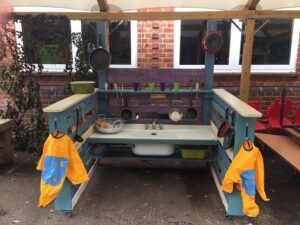
Photo by Kate Shelly
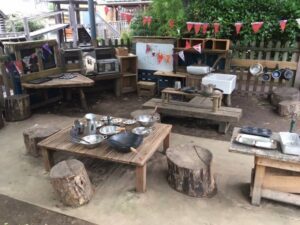
Photo by Sally McNeany – Natural resources are durable. As you can see from this image of a great outdoor space at Grove Nursery in Southward there is a great range of natural resources.
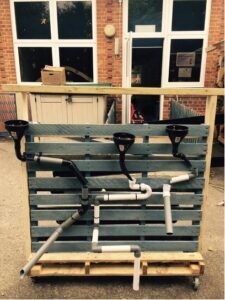
Photo by Sally McNeany – Guttering and tubing are always useful and can be found at your local scrap store or you could ask in your local Facebook group. These activities help develop problem solving skills, gross motor and is actively learning.

Photo by Kari McMullen – This is a fantastic resource as so many children love cars and this will really help develop gross motor and problem-solving skills.
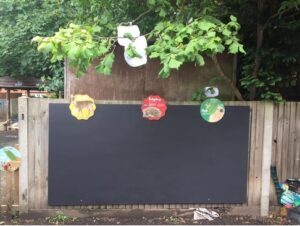
Photo by Sally McNeany – It’s great to provide places for children to mark make including white boards and chalkboards.

There is nothing better than using resources such as the above; real grown vegetables, interesting shells, fresh planted herbs, flowers, real cutlery, real grass. The skills children gain form playing with these are endless.
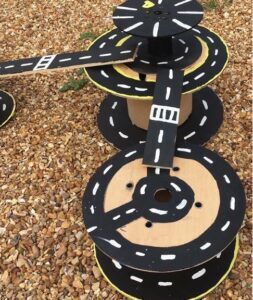
Source Unknown – Another great resource is cable reels! The things you can do with them are endless. They do get a little worn over time if outside so probably need replacing after each winter.
Below is a list of resources ideal for a purposeful outside environment:
Outside Resource List (Bilton, 2014):
Monkey bars, bird boxes, planks, ladders, tarpaulin, plastic crates, tyres, tree trunk sections, tents, cones, brooms, mops, hose pipe, imaginative props, builder’s tools, paintbrushes, pulleys, ropes and pegs, gardening tools, home tools, doctors bag, fishing rods, maps, jewellery, camping equipment, firefighting equipment, road safety equipment, cable reels, guttering, community blocks, real bricks, balls, hoops, bean bags, baskets and buckets, bucket stilts, spade, trowels, forks, gardening gloves, wheelbarrows, watering cans, seeds, plants, water butt, writing and drawing materials, compost – food waste. Pets, camera, dictaphones, books, fabrics, den making, giant scales, mud kitchen, trees and more trees..
Healthy and Safety
We have provided risk assessments in our resources section. The main thing to think about here is yes, every area should be risk assessed, before children go to it but we must ensure we are letting children take risks. We must assess the risk at the time and make a call. Children need to be allowed to take risks to enable them to learn.
Official guidelines on safely for children
Schools should have their own Health and Safety Policy which is a good idea to read and challenge if necessary. Statutory Requirements (Statutory Framework 2017) state that children should have daily access to outdoors unless the weather is dangerous. See also the DfE Health and Safety guidance for schools.
References:
- Department for Children, School and Families (DCSF) (2007) The Early Years Foundation Stage: Effective Practice: Play and Exploration. DCSF publications.
- Early Education (2012) Development Matters in the Early Years Foundation Stage. Early Education: London
- Statutory Framework for the Early Years Foundation Stage (2017) Department for Education: London
- Bilton, H (2014) Playing Outside. Activities, ideas and inspiration for the early year, second edition. Routelege

